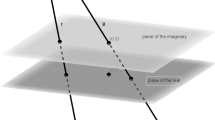Abstract
Poincaré’s conventionalism in geometry results from presupposing, as though this was a mere analytic judgment, that the sources of knowledge are only two—logic and experience—exclusive of each other and exhausting all the possibilities. That presupposition also led Einstein, via a misunderstanding of Hilbert’s axiomatic approach, to the idea that the axioms of geometry are empirical in character. Our knowledge of the non-logical principles of mathematics in general and of geometry in particular is synthetic a priori, but has epistemological attributes that are lacking in philosophy. That explains why all attempts at using the mathematical method to attain philosophical truth are doomed to failure.
Access this chapter
Tax calculation will be finalised at checkout
Purchases are for personal use only
Similar content being viewed by others
Notes
- 1.
Poincaré (1902, 65).
- 2.
Poincaré (1902, 5).
- 3.
Einstein (1921, 4).
- 4.
Einstein (1921, 5).
- 5.
Einstein (1921, 6).
- 6.
Paulsen (1875, 171, 173).
- 7.
Descartes famously distinguished between ‘clear’ and ‘distinct’ ideas, although he never quite explained his distinction. An idea can be clear without being distinct but it cannot be distinct without being clear. What is added to clarity by distinction? Leibniz, in one of his few published philosophical papers, tried to do better than Descartes by proposing that an idea is clear if we can ‘recognise the thing represented by it’ and it is distinct if in addition we can ‘enumerate one by one the marks which are sufficient to distinguish the thing from others’ (Leibniz 1684; cf. Loemker 1969, 291–292). More tersely, we may say that if an idea is clear, then there is at least one thing we think by it; and if it is distinct, then not more than one. The opposite of ‘clear’ is ‘obscure’ (or ‘opaque’, ‘foggy’), the opposite of ‘distinct’ is ‘confused’ (or ‘blurred’, ‘fuzzy’). To say of a philosophical concept or principle that it is obscure means that we are unable to think anything by it; to say that it is confused means that we are unable to think just one thing by it. For a very different interpretation of Descartes’s distinction, see Peirce (1878).
- 8.
This was probably true for the original axiomatisation of geometry by Euclid, who was apparently trying to realise Aristotle’s ideal (see Heath 1949). However, it runs against today’s consensus, according to which self-evidence and clarity are irrelevant to the selection of axioms (and definitions). It is interesting, and somewhat ironic, to note that Bertrand Russell gave in 1907 an interpretation of the rationale for an axiomatic system in mathematics that was quite similar to Nelson’s idea of the regressive method in philosophy as expounded later on in this lecture, and in fact used the same name (‘regressive’) to refer to it. Given that Russell’s paper was published posthumously and many decades later (see Russell 1973), it is very unlikely that Nelson knew about it. On the other hand, it is true that Russell mentioned the main point in passing at the end of the second paragraph of the Preface to Principia Mathematica (Whitehead and Russell 1910, v–vi, 1927, v).
- 9.
In spite of the differences in conception between Nelson, the defender of the analytic-synthetic distinction, and Quine, its arch-enemy, we see that there is agreement in one point: existential commitments are paramount when adjudicating between two theories.
- 10.
The example is taken from Kant, Inquiry Concerning the Distinctness of the Principles of Natural Theology and Morality of 1763, First Reflection, §1 (see Walford 1992, 249).
- 11.
This example corresponds to what mathematicians call a real definition as opposed to a merely nominal one. A real definition contains the instructions to construct the object, the nominal one just attaches a chain of words to a given term that might or might not have any actual reference. According to Nelson, as will become plain in the following lectures, philosophers abuse nominal definitions, fallaciously building their inferences upon them.
- 12.
This corresponds to the demand for validity in statistically oriented research.
References
Einstein, Albert. 1921. Geometrie und Erfahrung. Berlin: Julius Springer. [English translation: Geometry and experience, in Pesic 2007: 147–158].
Heath, Sir Thomas. 1949. Mathematics in Aristotle. Oxford: Clarendon Press.
Leibniz, Gottfried Wilhelm. 1684. Meditationes de cognitione, veritate et ideis. Acta Eruditorum, November. [English translation in Loemker 1969, 291–294].
Loemker, Leroy E., ed. and transl. 1969. Leibniz: Philosophical papers and letters, 2nd ed. Dordrecht: Kluwer.
Paulsen, Friedrich. 1875. Versuch einer Entwicklungsgeschichte der Kantischen Erkenntnistheorie [An essay on the evolution of Kantian epistemology]. Leipzig: Fues (Reisland).
Peirce, Charles S. 1878. Illustrations of the logic of science. Second paper: How to make our ideas clear. The Popular Science Monthly 12: 286–302.
Poincaré, Henri. 1902. La science et l’hypothèse. Paris: Flammarion. [English translation: The foundations of science: Science and hypothesis, the value of science, science and method, New York, The Science Press, 1929, 27–197].
Russell, Bertrand. 1973. The regressive method of discovering the premises of mathematics. In Essays in analysis, ed. Douglas Lackey, 272–283. London: George Allen & Unwin [Originally a paper read before the Cambridge Mathematical Club in 1907].
Walford, David, ed. and transl. 1992. Immanuel kant: Theoretical philosophy, 1755–1770. New York: Cambridge University Press.
Whitehead, Alfred N., and Bertrand Russell. 1910. Principia mathematica, vol. I. Cambridge: University Press.
Whitehead, Alfred N., and Bertrand Russell. 1927. Principia mathematica, vol. I, 2nd ed. Cambridge: University Press.
Author information
Authors and Affiliations
Rights and permissions
Copyright information
© 2016 Springer International Publishing Switzerland
About this chapter
Cite this chapter
Nelson, L. (2016). Lecture XI. In: A Theory of Philosophical Fallacies. Argumentation Library, vol 26. Springer, Cham. https://doi.org/10.1007/978-3-319-20783-4_12
Download citation
DOI: https://doi.org/10.1007/978-3-319-20783-4_12
Published:
Publisher Name: Springer, Cham
Print ISBN: 978-3-319-20782-7
Online ISBN: 978-3-319-20783-4
eBook Packages: Religion and PhilosophyPhilosophy and Religion (R0)




